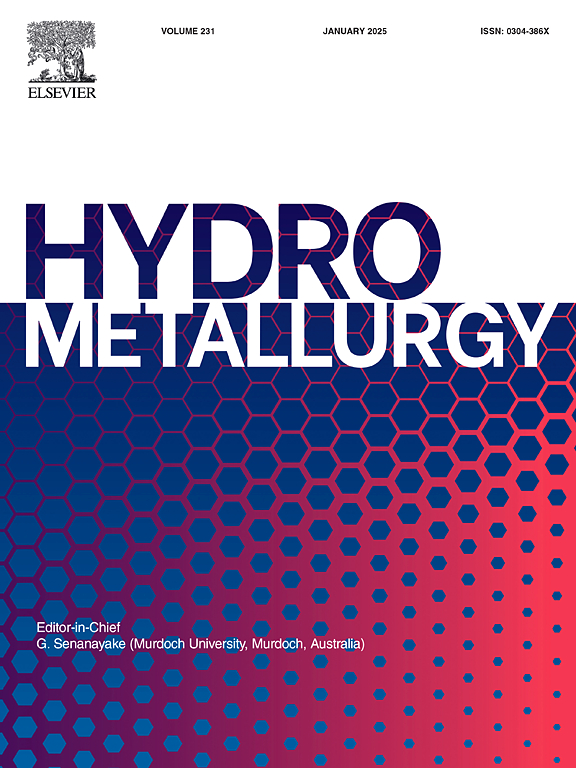Reaction and transformation behaviors of ferric oxides and titanium oxide in diasporic bauxite during an alkaline hydrothermal process
IF 4.8
2区 材料科学
Q1 METALLURGY & METALLURGICAL ENGINEERING
引用次数: 0
Abstract
Ferric and titanium oxides are the main impurities in low-grade bauxite that significantly affect alumina extraction in the Bayer process. This study aims to investigate the reaction and transformation behavior of ferric and titanium oxides in diasporic bauxite during a mild alkaline hydrothermal process to minimize the inhibitory effects of Fe and Ti impurities on bauxite digestion. Analytical techniques such as X-ray diffraction, X-ray fluorescence, inductively coupled plasma, scanning electron microscopy with energy dispersive X-ray spectroscopy, mineral liberation analysis, and Mössbauer spectroscopy were used to analyze the occurrence states of impurities in the raw bauxite and residue, explain their reaction mechanisms, and understand their transformation under hydrothermal conditions. Starch was used as a reducing agent to transform hematite into magnetite and facilitate the subsequent reaction of magnetite with anatase to minimize adverse effects. Thermodynamic calculations and results from experimental investigations showed that under optimized operating conditions of 180 °C, reaction time of 90 min, alkali concentration of 60 g/L, and a small quantity of starch, significant transformations of iron and titanium occurred. These include transformation of (i) hematite to magnetite (54.8 %) and (ii) anatase to Ti-containing stable phases such as ilmenite (19.7 %), ferrous pseudo brookite (12.7 %), ulvite (12.9 %) iron titanate, and perovskites. After the pretreatment with bauxite, alumina digestion can exceed 90.0 %.
铁质氧化物和氧化钛在铁质铝土矿碱性水热过程中的反应与转化行为
铁和钛氧化物是低品位铝土矿中的主要杂质,对拜耳法氧化铝萃取有重要影响。本研究旨在研究铁和钛氧化物在软碱性水热过程中在一水铝土矿中的反应和转化行为,以尽量减少铁和钛杂质对铝土矿溶出的抑制作用。利用x射线衍射、x射线荧光、电感耦合等离子体、扫描电镜-能量色散x射线光谱、矿物解离分析、Mössbauer光谱等分析技术,分析了铝土矿原料和渣中杂质的赋存状态,解释了它们的反应机理,了解了它们在水热条件下的转化。以淀粉为还原剂,将赤铁矿转化为磁铁矿,促进磁铁矿与锐钛矿的后续反应,减少不良反应。热力学计算和实验研究结果表明,在180℃、反应时间90 min、碱浓度60 g/L、少量淀粉的优化条件下,铁和钛发生了明显的转化。这包括(i)赤铁矿转变为磁铁矿(54.8%)和(ii)锐钛矿转变为含钛稳定相,如钛铁矿(19.7%)、亚铁伪绿铜矿(12.7%)、乌利维石(12.9%)钛酸铁和钙钛矿。经铝土矿预处理后,氧化铝溶出率可达90%以上。
本文章由计算机程序翻译,如有差异,请以英文原文为准。
求助全文
约1分钟内获得全文
求助全文
来源期刊

Hydrometallurgy
工程技术-冶金工程
CiteScore
9.50
自引率
6.40%
发文量
144
审稿时长
3.4 months
期刊介绍:
Hydrometallurgy aims to compile studies on novel processes, process design, chemistry, modelling, control, economics and interfaces between unit operations, and to provide a forum for discussions on case histories and operational difficulties.
Topics covered include: leaching of metal values by chemical reagents or bacterial action at ambient or elevated pressures and temperatures; separation of solids from leach liquors; removal of impurities and recovery of metal values by precipitation, ion exchange, solvent extraction, gaseous reduction, cementation, electro-winning and electro-refining; pre-treatment of ores by roasting or chemical treatments such as halogenation or reduction; recycling of reagents and treatment of effluents.
 求助内容:
求助内容: 应助结果提醒方式:
应助结果提醒方式:


